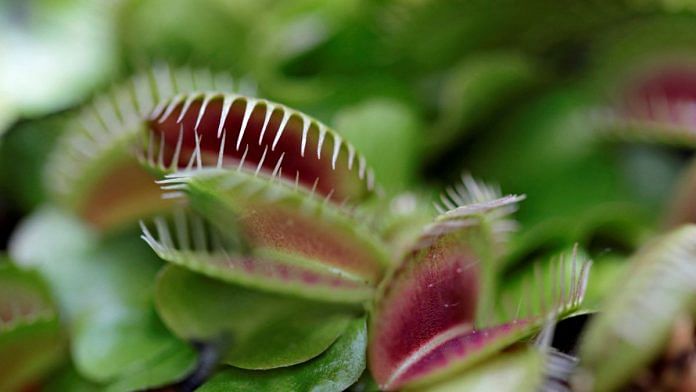Nearly 800 plant species have disappeared since the 18th century, while thousands more are considered functionally extinct – no longer playing a role in their environment, or are so rare they are no longer able to reproduce.
Scientists at the Royal Botanic Gardens, Kew in the United Kingdom estimate undocumented extinctions could put the number much higher. (Graphic — Why plants matter: )
“Most plant extinctions happen silently,” with plant populations vanishing without people noticing until the absence starts to take its toll on nature, said Eimear Nic Lughadha, a conservation researcher at Kew.
Losing plants is concerning because “we don’t know what was depending on that species in the ecosystem,” Nic Lughadha said. “And we don’t know what that species could be used for in the future.”
With the world’s remaining jungles and boreal forests still being destroyed to make way for things such as livestock, palm oil plantations or urban development, at least 40% of the world’s remaining plant species are in trouble, according to Kew’s 2020 State of the World’s Plants and Fungi report.
Green Planet
From the monkey-faced orchids and woody vines of the tropics to the boreal pixie-cup lichen and spearmoss carpeting the Arctic tundra, the world contains around 423,000 plant species on land — about 78 times the number of recorded mammal species.
Altogether, this greenery represents 82% of the weight of all living things.
But plants can be trickier to assess than animals, as botanists can’t follow a plant’s footprints across a savannah or listen for mating calls through a tangled forest.
As a result, scientists have assessed the extinction risk of only about 15% of species. That means we’re often not sure what the world is losing until it’s too late.
Within the plant kingdom, flowering plants – or angiosperms – make up the most diverse group at more than 369,000 species, and include colorful species such as Japanese wisteria and the Eastern redbud tree.
Among ferns and mosses there are nearly 34,000 species.
Conifers, or gymnosperms, such as the Douglas fir and Western hemlock, number just over 1,100 species.
Rooting Against Extinction
About two plant species vanish each year on average. That’s 500 times faster than the natural rate of extinction, scientists reported in a 2019 study in the journal Nature Ecology & Evolution.
Island-growing plants are at greatest risk because “there’s nowhere to escape to,” Nic Lughadha said.
In recent decades, scientists have worked globally to save and protect rare plants.
“There’s no technological reason why any plant species should go extinct today,” said Colin Clubbe, a senior researcher at Kew, standing in the gardens’ Temperate House, which he dubs “a cathedral to plants.”
Unfortunately, conservation efforts were not far enough along to save the Saint Helena olive tree. The stout and shrubby plant with its clutches of tiny pink flowers once grew on a South Pacific island before going extinct in 2003.
“So you’ve got a tombstone for it as a species. But there’s still hope we might one day find a surviving individual,” he said.
For centuries, scientists have been refining their knowledge about the world’s plant species by revisiting old survey sites and carrying out new ambitious field studies. They have managed to rediscover 537 plants thought to be extinct, according to Kew.
A Chilean crocus, Tecophilaea cyanocrocus, was found sprouting south of Santiago in 2001, for example — decades after the species was written off as a casualty of over-collecting by Victorian-era gardeners.
Even better, since the mid-2000s, scientists have been cataloging between 2,100 and 2,600 new species every year — far outpacing the number of plants that have vanished.
Planting for the Future
Scientists have now spent decades in sterile laboratories carefully cultivating the remaining individuals of vanishing species and saving seeds in enormous vaults. With an immense array of scientific tools at their disposal, it’s time to start planning for what comes next, scientists said.
Some botanists have even begun discussing outplanting species beyond their known native range as a hedge against climate change.
World leaders are attending a two-week meeting in Montreal, Canada, and hope to develop a global strategy for protecting and conserving nature before COP15 closes on Dec. 19.
One of the key aims is for countries to set aside 30% of their land for protection in the next seven years — providing potential safe havens for plants.
“We need to be looking out from the laboratories and out from the botanic gardens and into” the wild for restoration, said Clubbe. “We want to get them planted out and back into their historic distribution.” -Reuters
(Reporting by Gloria Dickie in London and Daisy Chung in Sunnyvale, California; Graphics by Daisy Chung, Simon Scarr and Jitesh Chowdhury; Editing by Katy Daigle and Lisa Shumaker)
Disclaimer: This report is auto generated from the Reuters news service. ThePrint holds no responsibilty for its content.
Also read: Researchers pinpoint genes responsible for dog’s behavior






